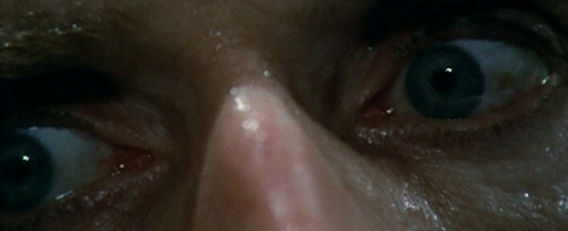
Some may find it hard to believe but there was more to the giallo genre than Dario Argento and Mario Bava. Whilst they had become the most respected and successful filmmakers, there were countless other directors who would leave their mark and help raise the profile of Italian cinema during the seventies. As well as the notorious Lucio Fulci, other artists to popularise the formula included Sergio Martino, Umberto Lenzi and Pupi Avati. Perhaps the unsung hero of the movement was Antonio Bido, whose two contributions – Watch Me When I Kill and The Blood Stained Shadow – would receive minor acclaim in their native country. They would adopt the familiar template of a black-gloved killer and a murder mystery-style narrative, like many of their contemporaries taking their cue from the works of Agatha Christie, although they would be less graphic than such offerings as What Have You Done to Solange? or Strip Nude for Your Killer. But over the last thirty years, they have slowly developed a cult following and have found a new lease of life on DVD thanks to both Anchor Bay and Shameless Films.
Watch Me When I Kill was heavily influenced by Dario Argento’s 1975 effort Profondo Rosso (aka Deep Red), which had successfully showcased graphic imagery with a dramatic score from prog rock band Goblin. The movie had utilised the clichés of its director’s earlier work to create something assured and stylish. Aware of the rising interest in the giallo film, Bido’s feature would be fashioned to cater for this new audience and would result in a successful theatrical run upon its release in 1977. Bido had been born in 1949 in Padua, a city located in northern Italy, where he would develop an interest in the movie industry from an early age. His earlier attempts had been art house films but soon it became apparent that if he was to continue working as a director he would have to create something commercial and met with producers Gabriella Nardi and Herman Cohen, the latter of which had previously been involved with the likes of I Was a Teenage Werewolf and Blood of Dracula some twenty years earlier.
After reading a treatment entitled Commissione omicidio (Murder on Order) by Vittorio Schiraldi, who had written and directed the 1973 drama Baciamo le mani (Family Killer), Bido immediately sensed its potential as his breakthrough movie. The story contained elements of Nazis and collaborators, who would result in the death of an innocent Jewish family, something which the investors felt was not box office material, and ordered for a rewrite. Enraged at not being consulted, Bido eventually agreed to compromise and combine aspects of both scripts, with the producers insisting that the film be of a similar style of Argento, whose earlier blockbusters included The Bird With the Crystal Plumage and Cat O’Nine Tails. Thus, the script was retitled The Cat with the Jade Eyes and the director was instructed to emulate Argento’s style, such as the use of the black-gloved killer, which was slowly become a staple of the giallo genre.
The project was financed through Elis Cinematografica, whose only previous credit was the little seen 1972 effort Il mio corpo con rabbia. The story would centre on the murder of a pharmacist in Rome, which would result in one of the witnesses, Mara, a cabaret performer, become the target of the killer’s deranged frustration and desires. Much like with Argento’s work, most notably The Bird With the Crystal Plumage, a vital clue as to the possible identity of the maniac lies in an abusive telephone call the heroine received, which is analysed by one of her friends in an attempt to isolate any distinct noises. This almost ludicrous form of enquiry if very Argento, often stretching the credibility of his plots to near breaking point, although as has been noted countless times before, despite the giallo being influenced by literature the actual narrative of the genre takes second fiddle to the onslaught of brutality and tension that the filmmakers are able to create.
Bido, who at that time was not familiar with the genre, immersed himself in Deep Red and managed to extract many of its winning formulas. There are various sequences which explicitly reference Argento’s film, a choice not of the director himself but of the producers which it was in his best interest to please. Another tool which he used was the point-of-view technique, often to signify that the killer was nearby and the protagonist was in danger. This was first popularised by Alfred Hitchcock in his seminal masterpiece Psycho had has since been used by almost every director whilst making a serial killer movie, from Halloween to The Silence of the Lambs, and The Cat with the Jade Eyes was no exception. In fact, Bido had confessed to being a huge fan of the legendary filmmaker and one sequence in particular, a scene where one of the characters has his throat slashed whilst lying in a bath, was an explicit homage to the iconic shower murder, not so much in location but in his decision to outdo Hitchcock with the amount of cuts to be featured in one scene.
The casting would become a troublesome affair when the director’s initial choice for his lead was forced to back out of the project at the last moment. French actor Philippe Leroy had been in the running for the role of Lukas, who would assist Mara in her investigations, but the star eventually got cold feet when the investors refused to commit to a deal and so Leroy instead accepted an offer from the Incorporated Television Company to play the pivotal role of Yanez De Gomerain the miniseries Sandokan. The role was then offered to Corrado Pani, a forty-year old Italian actor who had enjoyed tremendous success in theatre, as well as a movie career that covered twenty-five years. For the part of Mara, suggested approaching Paola Tedesco, a young model who had appeared in Playboy as well as various television shows. Unsure as to her acting ability, Bido insisted that the star provide a screen test and was immediately satisfied. Other roles were offered to Giuseppe Addobbati, who had previously collaborated with Schiraldi on Family Killer and Franco Citti, whose career had reached its pinnacle with the role in The Godfather.
The director was determined to avoid cheap exploitation by resorting to unnecessary nudity or gruesome violence and so the end result is somewhat restrained in both regards, Bido instead focusing on the atmosphere and plot twists. The movie was shot in his home town of Padua and Rome, where the majority of the filming took place. Using 35mm film, Bido worked closely alongside his cinematographer, Mario Vulpiani, except for the point-of-view sequences which he chose to shoot himself as he was less than impressed with Vulpiani’s efforts. The scenes that were filmed in Padua remain the only elements of Schiraldi’s original draft to remain intact, with the remainder of the script being tailored to capitalise on Argento’s international success. The structure of the story in some ways echoed Cat O’Nine Tails, and at times even the look of the movie closely resembles Argento’s sophomore effort.
Perhaps the most significant element of of the movie to be so derivative was the score, a highly effective composition which blatantly plagiarised Goblin‘s work from Deep Red. This had also been a decision of the producers and had been created by Mauro Lusini and Gianfranco Coletta, working under the banner Trans Europa Express, whose one contribution to the world caused many to speculate as to whether it was in fact Goblin using a pseudonym. The movie was finally released in Italy on August 6 1977 and became a huge success, out grossing both The House With the Laughing Windows and Mario Bava’s final film Shock. For its American release, the distributors decided to give it a more sleazy title to cater to fans of exploitation cinema and instead opted for Watch Me When I Kill, which would become its most known moniker. Over three decades later and Bido is finally starting to receive praise for his work, with his feature debut still standing as his crowning achievement.


2 Responses to SPAGHETTI SLASHERS – Watch Me When I Kill